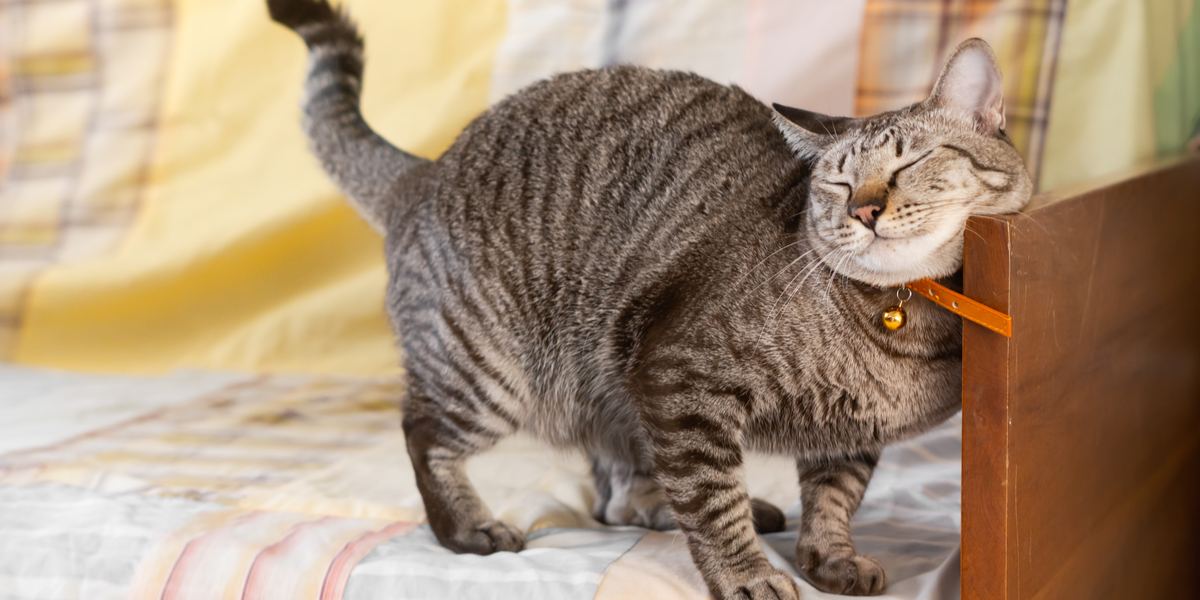
To humans, cat behavior can seem strange. At times they do things that might seem annoying or cause damage. This is why, if you have a feline family member, it’s essential to understand some basic cat behavior, including territory marking and other forms of scent marking. So, how do cats mark their territory? Let’s find out.
How Do Cats Mark Their Territory?
Cats have many ways of sending signals to other cats. They have scent glands on their face, body, and paws that release pheromones. They also send smelly signals in their urine and feces to mark their territory and communicate with other cats. Here are some of the ways that cats mark their territory:
Scratching
Cats have scent glands in their paws, around their nails and their paw pads. When they scratch, they leave their scent while keeping their claws in good shape. Scratching a variety of vertical and horizontal surfaces also helps cats stretch their muscles. The smell, alongside the physical scratch marks, helps show other cats that it’s their territory.
Urine Spraying
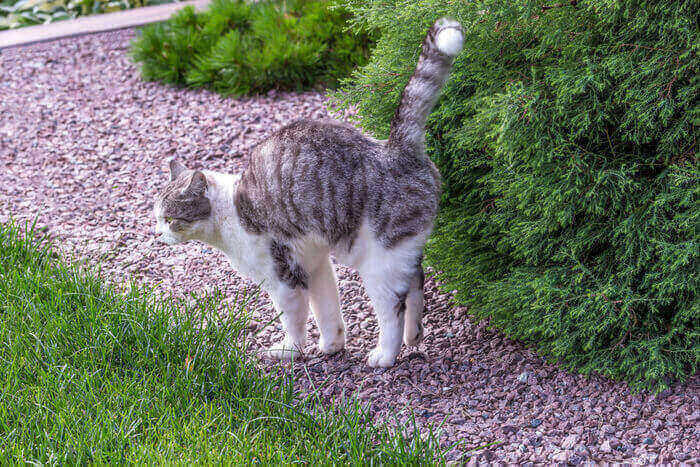
Both male and female cats spray.
Cats don’t spray every time they pass urine, and spraying is more common among cats who aren’t neutered. Urine spraying is usually done on vertical surfaces like walls, curtains, furniture, or foliage.
Cats spray to mark their territory or attract a mate. Still, they can also spray due to stress or changes in their environment or routine. Even if they’re not spraying, cats use urine marking to demonstrate ownership of resources like their litter box or the best toileting patches in the garden.
Inappropriate urination could be a sign of a medical problem like a urinary tract infection. If you have any concerns about your cat’s urination or other cat behavior problems you should speak to your veterinarian. They may be able to recommend a calming product like a Feliway or pet remedy diffuser.
Pooping
Cats have anal glands in their bottom that produce scent material. This scent gives other cats information about a cat’s gender, age, health, and reproductive status, as well as letting them know whether they are a friend or foe!
This foul-smelling substance is stored in the anal sacs until the cat passes feces. When poop squeezes out of the anus, the pressure empties the anal sacs, and the scent material is deposited, too.
Face Rubbing
The congregation of scent glands on a cat’s face allows them to mark their territory by face rubbing. You might notice your cat doing this around your home or garden, on corners of walls, furniture, or fences. This is because cats commonly use this technique to mark familiar surroundings where they feel safe, secure, and content.
Rolling
Cats have scent glands on their flanks as well as their face. So, when you see them rolling around on the patio, in the dirt, or on your doorstep, they’re actually spreading their scent to mark their territory.
Rubbing
When they’re not rolling on the floor, cats also scent mark by rubbing their bodies against surfaces as they walk. You might spot your cat walking alongside the garden wall leaning against it. This means they are marking their territory and making other cats aware that the garden belongs to them.
How Do Cats Mark Their Humans?

When your cat rubs up against you, they’re marking you are their personal property!
It’s not just objects and surfaces in their environment that cats scent-mark. They also scent mark their favorite people. So, suppose you have a furry family member at home. In that case, you might see them doing some of these behaviors to let the other family members know they care:
Bunting
Bunting is when cats headbutt you. But rather than being aggressive or unpleasant, it’s actually a sign of affection. Cats have a cluster of scent glands on their forehead, so when they lovingly headbutt you, they’re marking you with their scent. This scent marking behavior is a massive compliment because it means they trust you and feel safe.
Face Rubbing
Like bunting, when cats rub their face against you, they’re marking you with their scent. They have scent glands on their cheeks that release pheromones when rubbing against you. So, now you know that when you’re enjoying an affectionate moment with your purrfect pal, they’re saying they love you, too.
Nibbling
Has your cat ever rubbed their face against your chin and then opened their mouth to take a little bite? Or perhaps they’ve rubbed their face against your cheek and ended up nibbling your ear? These little bites aren’t meant to hurt. They’re a sign of love and, again, serve the purpose of scent-marking due to scent glands situated around the lips.
Kneading
If you’ve got a feline friend, you’re probably familiar with this scenario. You curl up on the sofa in the evening with your chosen beverage, and your cat joins you. But instead of settling on your lap right away, they pace round in circles, kneading and padding with their paws and getting their claws stuck in your favorite lounge trousers.
So, why does your cat insist on performing this irritating ritual before they will relax? Cats have scent glands in their paws that release their scent as they knead or scratch. By kneading on your lap, they’re making sure their cozy spot smells of their odor to make them feel safe and reassured.
Leg Rubbing
Does your cat rub against your legs when you arrive home? Or maybe when you’re in the kitchen, and they want to be fed, they make sure you’re aware by weaving through your legs and meowing loudly?
When they do that, they transfer their pheromones onto your legs or clothes. Not only will other cats be aware that you’re off-limits, but the scent will make your cat feel safe and reassured.
Conclusion
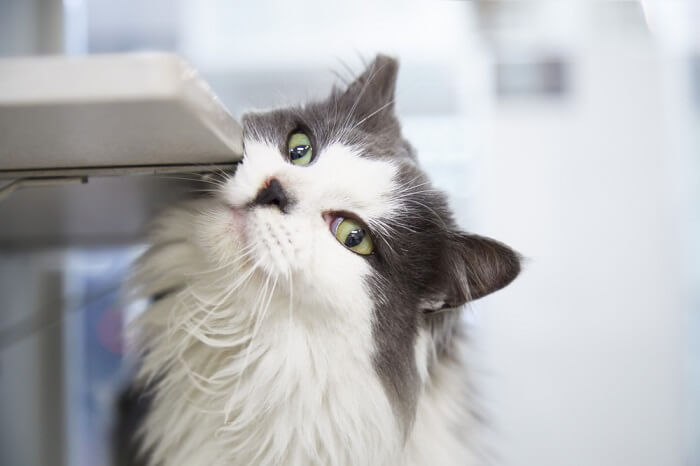
From being a real-life trip hazard as they weave around your feet to snagging your coziest blanket with their kneading, cat behavior can be baffling and frustrating. However, once you understand that these behaviors are often a demonstration of their love for you and the home you share with them, you might find the behavior more endearing!
Also Read: How Do Cats Choose Their Favorite Person?
Frequently Asked Questions
How does a male cat mark its territory?
Male cats may be more likely to mark their territory by urine spraying if they aren’t neutered. Their urine will smell much more strongly than a neutered male’s urine, and tomcats use this scent to attract a mate.
However, neutered male and female cats will still occasionally spray urine, especially if they’re stressed or facing a change in their routine. And, of course, intact males will still do all the usual feline scent-marking alongside urine spraying.
Do indoor cats mark their territory?
Indoor cats still mark their territory. They will face rub, bunt, and knead, to mark their familiar environment with their scent.
However, they might also start spraying around the house if they are unneutered, stressed, or anxious. If this happens, you should consider neutering them and consult your veterinarian for more advice.
What age do male cats start spraying?
Every cat is an individual, and their behaviors will vary. However, urine spraying in male cats tends to be associated with sexual maturity. Therefore, male cats may start spraying as early as 6 months old as their testosterone levels start rising.
If your cat is neutered at a young age, they’re less likely to spray because they don’t have the motivation to find a mate. However, other behavioral causes of spraying are possible, and inappropriate urination can sometimes indicate a medical condition like feline lower urinary tract disease.
So, if you and your cat are struggling with spraying issues, speak to a veterinarian or a certified animal behaviorist.
Do male cats mark after being neutered?
After neutering, it’s much less likely that male cats will spray. However, there are other behavioral causes of spraying, and these are just as likely whether or not your cat is neutered, no matter which sex your cat is.
These causes include stress or environmental changes, and can be frustrating to resolve. Remember, though, that urine spraying is not the only form of scent marking cats do. Even after neutering, you can expect your male cat to spread their scent by rubbing, rolling, or headbutting.



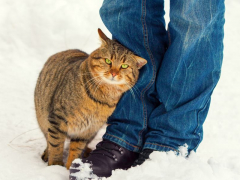

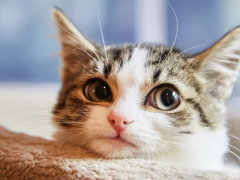


I love that there is a place to learn more about cats! I have a large (32 lbs.) male Maine coon cat that is 8 years old–he used his litter box faithfully until about 3 months ago, when he suddenly began pooping on only the living room carpet! We are at a loss to change this! Why did this happen and how can it be corrected? He shares the litter box with a small 6 lb. female Siamese cat who is 16 years old. They are good pals as the Coon cat was 8 weeks old when introduced to the Siamese, who was 8 years old at the time and thought he was her kitten. Sure would appreciate your help.
Hello Lois, thanks for the comment. At that age and weight, it’s also likely that he would suffer from constipation, and this could make pooping painful. I wonder if he is going outside of the litter box in an attempt to avoid the pain associated with that place. Are his poops the same size and consistency as they’ve always been? Does he strain at all? If you’ve ruled out any health issues, did anything change around three months ago that might be stressing him or deterring him from the litter box? The fact that he’s only pooping outside of the litter box and not urinating outside of it does seem to suggest an issue directly related to that defecation, but it could also be a response to something in the environment. Hope you’re able to solve this soon!